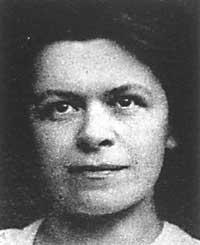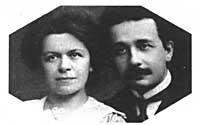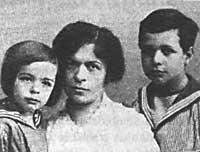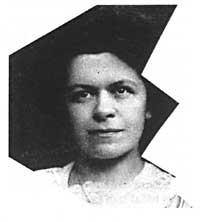Mrs. Einstein: unexpected discovery
Elhuyar Fundazioa

In encyclopedias and books showing data on Einstein's biography, hardly any reference is made to his first wife: Mileva Maric. His wife was mathematical and physical and, in recent times, some have made it public, and it is no less: mathematician and physicist who can collaborate with her husband Albert in creating the theory of relativity. The key to the problem lies in the scope of this collaboration.
Albert and Mileva Einstein worked together and published on behalf of both their first scientific papers. This is the statement that is hidden at the base of the storm that arose among scientists as a result of the publication of letters and writings of Albert Einstein by the University of Princeton. In Albert’s letters to Mileva, referring to the work on relativity, he used the expression “our work”.
Everyone seems to recognize that in these works the role of Mileva Maric was more important than has so far been known or recognized. But controversies arise in assessing the scope of this importance. And it seems not joking! The “heat” that some researchers have exposed in discussions on the subject is not common within the scientific community. Let's see what is known about this story.
Biographies of Einstein
Albert Einstein was born in 1879 in Ulm, Germany. As a young man he moved with his family to Munich, where he studied at the Catholic Institute, although he was a Jew. In 1894 his family had to go to Milan, but the young Albert stayed in Germany to finish high school. Before finishing he left school: as he was only interested in mathematics, he followed the advice of a teacher and went to Italy to his relatives.
He traveled from Italy to Zurich with the intention of studying at the Polytechnic School, but he was not accepted and had to wait a year learning on his own. The following year, in 1896, he succeeded in joining the Zurich Polytechnic School, called Eidgenössische Technische Hochschule (ETH). There and that same year he met Mileva. Both had the same courses in that first year.

Mileva Maric was the daughter of a Serbian official. He was born in Titel (then Hungary and now Yugoslavia). Her admission to the ETH in Zurich highlights Mileva's intellectual level, as it was not easy to accept women for high-level scientific studies at the time.
Albert graduated, but Mileva did not manage to pass the exam, although with very similar notes. Both remained in Zurich while Albert found his teaching work. But it was not an easy search, because besides being Jewish, he did not have a Swiss citizenship. In 1901 he obtained Swiss citizenship and began working at the Bern patent office.
The work of the Patent Office left him enough free time and, not needing a laboratory for his work (he already had enough paper, pen and intelligence), published his first scientific article that same year. In 1902 Mileva had a daughter named Liserl. Meanwhile, Mileva and Albert were not married and although we do not know if the reason was or not, what we know is that their mother took her daughter to Serbia to give her to a caregiver. There is no trace of this daughter and nothing more is said about her in Albert Einstein's biographies.
The following year, in 1903, Albert and Mileva married and a year later the boy Hans Albert emerged into the world. Those early years of the century were prolific in the life of Albert Einstein. The year 1905 has deserved the qualification of “annus mirabilis”. That year Albert Einstein published five articles in which each touched a different theme. Three of these five have made room among the most important articles in the history of physics.
Let us now follow the chronology in which these articles were published. In the first one it was based on the idea that Plank had launched five years earlier, that energy, like matter, was organized into how many or discrete units. He related the frequency of electromechanical energy to quantum energy.

To say that the purple light has a double frequency of red light, for example, meant that its quantum energy was also double. This theory was forgotten and Einstein resumed it and applied it to phenomena inexplicable by classical physics, such as the black body. Thus Einstein laid the foundations of quantum mechanics. Several years later he received the Nobel Prize for this work, although this is not his most admirable work (if it is possible to say so).
In his work, published two months later, he developed the mathematical model of the Brownian movement. It related the movement of suspended particles in a liquid to that of liquid molecules.
The third provoked the deepest revolution in the world of physics: it laid the foundations of reduced relativity. Time and space lost their independence and variability until then and became relative terms. This new scheme led to devising the relationship between mass and energy, provided by the hyper-known E = mc 2 equation. This new idea allowed us to explain many phenomena.
In the written biographies of these prosperous years of Albert Einstein, only brief references have been made to his wife. The famous biography written by Ronald Clark in 1971 speaks of “imprisonment of the daughter of a slave peasant” and “recognition that the men and women Einstein encountered in his daily life were incomprehensible to relativity.” So according to Clark, Mileva didn't understand her husband's work.
Open debate
Documents published after Einstein's death have belied Clark's claim. Some people think that Mileva did more than understand in these works: he participated directly in the development of these concepts. Evan Harris Walker is one of the most passionate advocates of this idea.
In his opinion, Albert and Mileva worked together, though they spent long waves separated from each other. Proof of this is Albert's letter to Mileva. In the letter of March 27, 1901, Albert says: “How happy and proud we would be, if together we bring our work on the relative movement (relativity) to a final point of success.”

In other letters, Einstein also makes comments that they might assume collaborated. Collaboration also reached other non-relative areas. Albert's early work of the century analyzed thermodynamics, molecular forces and Brownian movement. Let us look at other examples of these issues.
“I’m working with another method in researching the Thomson effect, which has similarities with yours to know the dependence of T of k.”... “I’ve had a very fruitful idea, which allows us to apply our theory about molecular forces to gases.”... “I’ve given you our article” “Think how wonderful it will be when we can go back to work together, I don’t think..... Among the discoveries made by Walker there is another interesting fact.
Walker is based on data written by the Hungarian mathematician and physicist Desanka Trbuhovic-Ghuric in the biography of Mileva Einstein. This biography was translated into German and published in Switzerland in 1988. Author Abraham F. He received the testimony of the prestigious Russian physicist Joffe (1880-1960). Joffe's article on relativity was published in 1905 as a member of the magazine, Annalen der Physik.
According to Trbuhovic-Ghuric, Joff had the opportunity to see the original of the article in that year and recalls the signature of Einstein-Marity. Marity is a Hungarian variant of the name Maric. It is surprising that Marity is the form used by Joffe. That was what appeared in the spouse, but Albert's biographers have never used that name. This gives more credibility to Joff's testimony. This manuscript is lost forever. What is currently preserved is in 1943. The US commission asked Albert a scribe to help the war. Einstein manually copied the famous article with the following comment: “This is the copy of my first article on the theory of relativity. Copy made in November 1943. The original manuscript does not exist, because I will throw it after publication.”
In 1908 he obtained a professorship in Bern and in 1909 at the University of Zurich. In 1910 Mileva gave birth to another boy whom they called Eduard. In 1911 he became a professor at the German University of Prague, but after a year he returned to Zurich. By then Einstein's name had become famous among the physicists of the world.

In 1913 he moved to Berlin after accepting with Mileva and her two sons a post created for him at the Institute of Physics. For the first time he received enough salary to devote himself exclusively to research. It was the last months together.
The following year Mileva returned to Zurich for vacation with her two children. I. They began the World War and could not return to Berlin. They did not meet again and years later they were legally separated. The friendly divorce document (1919) contained a surprising chapter: Albert Einstein would award Mileva the Nobel Prize in case of winning this prize. In 1922, Einstein received the Nobel Prize and, as he promised, traveled to Zurich to donate money to Mileva.
What Walker deduces from all this is: That the name of Mileva Maric could appear together with Einstein as a co-author or collaborator, so she also received the Nobel Prize between the two, as happened in the case of the Curie.
Some say that Walker's hypothesis is not an abuse: at that time it was normal for women to assume the work of men. Therefore, Einstein was nothing more than the behavior of any normal man. Troemel-Ploetz adds another example. Mileva from Zurich invented a device to measure weak electric currents. The device was patented on behalf of Albert Einstein and his physical friend Johann Conrad Habicht. According to Trbuhovic-Ghuric, when a friend asked Mileva why her name did not appear in the patent, her answer was: “And for what? we both form a stone” ein Stein = a stone with a play of words.
Troemel-ploetz also mentions a letter from Mileva to her father: “Very recently we have finished an important job that will make my husband famous all over the world.”

John J. According to Stachel, a member of the Boston University Einstein Seminar and director of the publication of Einstein's letters and writings, the historical data we have so far cannot be deduced from the similar weight of Mileva's collaboration. Although these findings from Einstein's youth papers have given a little more light on those years, there are still dark aspects of Einstein's myth. Stachel believes Walker's ideas are just fantasies: The terms “we” and “we” were used by Albert in the warmth of love, but not with the intention of expressing the authorship of his work.
Some say they are just fireworks. Others may be another example of the female works that history has hidden from us. Meanwhile, there has been some debate and conflict in the scientific community. Science also has its heroes (male?) and will not easily admit the slightest crack in that image.
A. During these days a new book on Einstein's life, nature, attitudes and scientific contributions has been published among us. It is the work "Albert Einstein: kosmo pentsari" by José Ramón Etxeberria (Gaiak, San Sebastián 1990).





